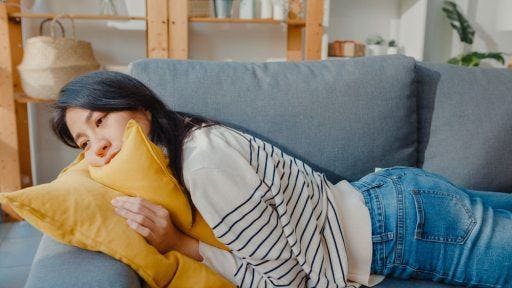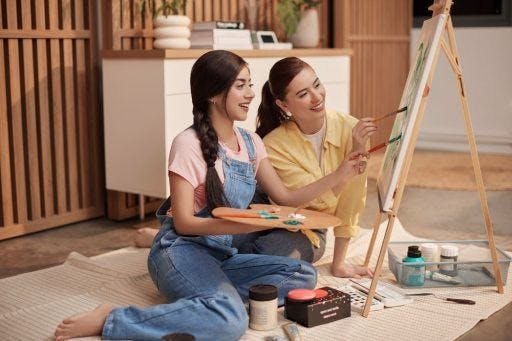The future is unpredictable. Will this presentation be a hit? How will this date go tonight? Will the frozen steak thaw in time for dinner? Such uncertainties can fill your mind with all-consuming what-ifs and overwhelm you with stress. If you’ve found yourself in a similar situation, know that you can lean on various ways to take the edge off your troubled thoughts. Read on to learn how to deal with anxiety through self-care activities.
Set a Worry Time

Light your best candle. Put on the softest silk robe you have. Pretend you’re an A-lister at a daytime talk show and pour your feelings out. This is worry time, when all you need to do is, well, worry! No need to problem-solve or plan out a solution. Just let your mind wander around.
When you sense anxiety creeping on you, your first instinct is to ignore it. However, suppressing your emotions will only make them louder. Psychotherapist Jennifer Shannon calls anxious thoughts the monkey mind, constantly jumping from one branch to another and demanding attention. In her book Don’t Feed the Monkey Mind, she encourages people to set aside 10-20 minutes daily to “worry your head off.” If you don’t know where to begin, she recommends answering these two questions:
- What is the worst thing that could happen?
- If it comes true, how would it impact my life and future?
The worry time helps you become more resilient to uncertainty. You’re also granting yourself the space to validate your feelings and acknowledge that, yes, anxiety is a part of your experience, but it doesn’t define you.
Get Your Heart Rate Up
Exercise might be a cliché addition to this “how to deal with anxiety” list, but it’s a real game-changer. A study published in Advances in Experimental Medicine and Biology found that physical activity significantly reduces the symptoms of anxiety, including but not limited to fatigue and difficulty sleeping. The more you work out, the more feel-good endorphins your brain releases, therefore lowering stress levels.
Getting into the habit of regular exercise can be challenging at first, so don’t dive headfirst into an intense routine. Start small with a sport or activity that interests you, like golfing, dancing, or biking. You can also take a brisk walk around the neighbourhood before or after work if you have a busy schedule. As for the duration, Australia’s physical activity and sedentary guidelines recommend doing 2.5-5 hours of moderate workout per week or 1.25-2.5 hours of vigorous exercise per week.
Eat a Well-Balanced Meal

Yes, salad is healthy. But if your bowl only consists of greens and the tiniest drop of olive oil, your meal lacks essential proteins, carbs, and fat. Meanwhile, indulging in highly processed food is not only unhealthy but can also potentially increase your risk of developing an anxiety disorder, as research suggests. So, finding that sweet spot where taste, nutrition, and satisfaction intersect is crucial.
Incorporate a variety of nutrient-dense food into your diet. Think of it like a seesaw where you must balance everything. For example, enjoy your barbecue with a side of asparagus, corn, and sweet potatoes. And if you really love salad, go ahead and put avocado slices or grilled chicken strips on top. One study in Psychiatry Research also discovered that prebiotic food, like pickles and kimchi, can help lower social anxiety. Fancy a kombucha?
Face Your Insecurities
Anxiety has many triggers. Often, your insecurities are the culprit behind the negative thoughts lingering in your mind. It’s okay, though. Imperfections are a natural part of being human. But mastering how to deal with anxiety requires acknowledging them with kindness and curiosity.
Ask yourself where these insecurities stem from and how they affect you. Perhaps you’re nervous about meeting new people because you don’t feel confident with your crooked teeth. Instead of focusing on what you perceive as a flaw, shift your attention to embrace self-improvement. In this case, you can rely on aligners like ClearCorrect to turn your smile into an asset. They gently move your teeth to an ideal position without causing any discomfort. Plus, they’re discreet and removable, so no one will know you’re in treatment.
Channel Your Inner Child and Colour

Several studies have reported the positive effects of colouring on anxiety levels. This de-stressing activity can distract your mind from overthinking and let you enjoy the present moment. It helps stimulate creativity while simultaneously relaxing the brain.
There’s no right or wrong way to do this, making it a wonderful escape for perfectionists, too. You can colour outside the line, make little patterns, and experiment with shading. When you see the result, you’ll feel a sense of accomplishment. Who knows, maybe you’ll upgrade the colouring book to canvas and oil paint soon.
When you’re learning how to deal with anxiety, listen to the signals your body is sending. What is it craving? Are you feeling overwhelmed? Self-care activities can tune out negative thoughts and keep you grounded temporarily. Remember, if your anxiety reaches a point where it disables you to function properly, seek out professional help.
References:
Aucoin, M., LaChance, L., Naidoo, U., Remy, D., Shekdar, T., Sayar, N., Cardozo, V., Rawana, T., Chan, I., & Cooley, K. (2021). Diet and Anxiety: A Scoping Review. Nutrients, 13(12), 4418.
Department of Health & Human Services. (2015). Exercise and mental health. Better Health Channel.
Hilimire, M. R., DeVylder, J. E., & Forestell, C. A. (2015). Fermented foods, neuroticism, and social anxiety: An interaction model. Psychiatry Research, 228(2), 203-208.
Kandola, A., & Stubbs, B. (2020). Exercise and Anxiety. Physical Exercise for Human Health, 1228, 345-352.
Samuel, B., Wang, H., Shi, C., Pan, Y., Yu, Y., Zhu, W., & Jing, Z. (2022). The effects of coloring therapy on patients with generalized anxiety disorder. Animal Models and Experimental Medicine, 5(6), 502-512.
Shannon, J. (2018). Don’t feed the monkey mind: How to stop the cycle of Anxiety, Fear & Worry. Read How You Want.
Turturro, N., & Drake, J. E. (2020). Does Coloring Reduce Anxiety? Comparing the Psychological and Psychophysiological Benefits of Coloring Versus Drawing. Empirical Studies of the Arts, 40(1), 3-20.



